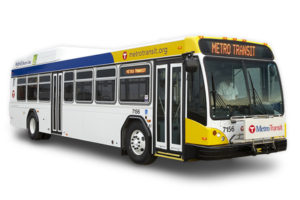Few Minnesotans know who Mark McLaughlin or Herman Liebelt were. For the safety of our transit operators, this is a crying shame.
You see, on Black Friday 1998, in the mid-afternoon, Mr. McLaughlin was peacefully driving King County bus number 2106 with 34 passengers on board. His route was number 359, Aurora Avenue from the Snohomish County line to downtown Seattle, Wash. If it weren’t for the events of that fateful day, it wouldn’t matter so much who knows or doesn’t know who he was.
As the bus pulled onto the George Washington Bridge at 49 miles per hour, a mentally disturbed passenger jumped up and shot Mr. McLaughlin twice, then shot himself. The bus driver’s last act was to try to stop the bus. He only managed to slow it down to about 40 before it careened off the edge. Fortunately, that was just enough to keep three deaths from becoming 35. The bus landed on top of an apartment building 50 feet below. Had it gone much farther, it would have plunged into the Lake Washington Ship Canal, drowning everybody.
Everyone survived except Mr. McLaughlin, the killer and an innocent passenger named Herman Liebelt. (I am deliberately not using the killer’s name in order to not glorify him or his act.) However, the passengers who didn’t die weren’t necessarily “lucky”; some of them had permanently disabling injuries, and at least one online commenter on a news article about the incident alleges to have become addicted to opioids due to her injuries.
Fast forward to Minneapolis, April 12, 2018: There was a segment on the local news with video of someone boarding a bus and beating up the driver. As I write this column and am doing research on the subject, I just discovered another brutal attack on a Twin Cities bus driver a week later. The second one was even worse: two against one.
As far as I know, no bus drivers in the Twin Cities have lost their lives for the job—yet. However, even a minor assault on someone driving a moving vehicle—say, spitting on them or throwing a crumpled-up schedule or transfer in their face—can cause a safety hazard. It’s not just the injury, it’s the distraction. Common sense tells you that when someone is in fear of bodily harm they can’t concentrate very well on anything else.
Twin Cities Metro Transit is currently testing 20 shatter-proof glass shields on random buses to see if they help protect drivers, and to get feedback from both drivers and the public about whether or not the program should be expanded.
Here’s where I am going to break objectivity: Of course this program should be expanded. And the choice of which buses to install shields on shouldn’t be random, the priority should be route-specific, until such time as each and every bus is equipped, if that is deemed desirable. The bus drivers and passengers all pretty much know which routes are problematic. “Political correctness” isn’t funny when it puts people at risk. My educated guess is the people who drive the 645 and 672 to Wayzata don’t worry much about this stuff (Yes, I ride those routes on occasion and have literally never heard so much as an argument on either one), whereas the two most recent highly publicized major incidents happened on the 5 and the 18.
Even Canada, our supposedly “less violent” neighbor to the north, has been plagued with attacks on bus drivers, but their transit systems are acting more quickly and decisively to do something about it than our transit agencies in the good old United States of America.
Winnipeg Transit had a driver stabbed to death at the end of the line just a couple of months ago. Another Winnipeg driver was spat on in 2016 by someone who didn’t want to pay the fare. In Edmonton in 2009, a driver was stomped to death during the morning rush hour. In Delta, British Columbia, in 2015, a passenger sprayed a driver in the face with bear spray and then threatened to do the same to an innocent citizen. (Mace is illegal in Canada—unless it says on the label it’s for protection from animals. In this case, the real problem is the animal who bought it.)
I could go on and on, but the point is that violence on public transit endangers everybody, not just the intended targets, and scares people away from using what would otherwise be a valuable public service. Ask yourself: If you had a 12-year-old daughter, would you let her ride a bus by herself, say coming home from the downtown library when it closes at 9 p.m.? Unless and until you can honestly say yes, our transit system needs to work on this.























